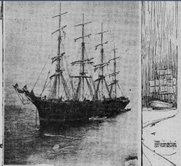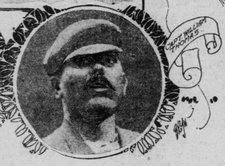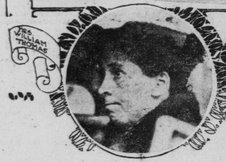Story by John Vonderlin
Email John: [email protected]

Hi June,
Here’s another shipwreck story, this one on Pedro Point, that I found in the September 5,1904 issue of “The San Francisco Call.” I wonder how they got the Captain’s wife’s photo? Maybe that is why she didn’t want to do an interview, after having the flash powder go off in her face, probably without notice.
This was just one of four shipwrecks that happened in a 24 hour period because of the thick fog.
The Drumburton, according to later articles, was stripped of everything possible, and its skeleton’s remnants probably are still buried somewhere off the Point to this day. It could have been worse, as the 267 foot long, 40 foot wide ship, was rated for 1,773 tons of cargo and was carrying only ballast. Enjoy. John

Four-Master Drumburton Is on Rocks Off Point Pedro, a Total Loss;
IRON SHIP THAT DRIFTED ON THE ROCKS OF PEDRO POINT SATURDAY NIGHT DURING A DENSE FOG AND WHOSE HARD BED GAVE EVERY PROMISE OF MAKING A NEW ADDITION TO THE “GRAVEYARD OF VESSELS” ON FATEFUL PROMONTORY.
The four-masted iron ship Drumburton, lies jammed on the rocks off Point Pedro. She was towed from this port Saturday and set on her way to Seattle. A dense fog settled upon the ocean and in a dead calm the ship drifted with the current southward through the white silence. At about 7 o’clock Saturday night she crashed bow foremost on the rocky bottom of the Point. There is little hope of her being taken off. A ragged hole is punched in her hull and she is filled with water. The vessel was sailing in ballast at the time and the only loss sustained is about $45,000, the value of the Drumburton. This is offset by $38,000 insurance.
Captain William Thomas, the skipper, seemed dazed by the catastrophe when interviewed yesterday. “I don’t know how it happened,” he said. “We’re here. I wish we were not. Lost my bearings? I had nothing to take bearings by. We drifted and struck on the rocks. That’s all I know.”
The Drumburton left port at 10 o’clock Saturday morning. With Captain Reed as pilot the ship was towed through the Golden Gate, and spreading her sails headed north. The explanation given for her running aground so far south is that the currents bore her there. Captain Thomas would make no statement. The chief owner, Captain John Barneson, is satisfied with the theory of the strong currents. He says that it is plausible that the vessel was carried down the coast and sucked ashore by the same treacherous rush of waters that ran the James A. Garfield ashore yesterday and hurled the British bark Gifford on
the rocks a year ago.
CALL THROUGH THE FOG.
At about 7 o’clock Saturday night the inmates of the Point Pedro Hotel, about a mile from this “graveyard of ships,” heard the boom of a rocket. J. A. McGowan hurried down and ascended the high bluff known as Little Pedro Point. He could see nothing at first through the heavy fog. Suddenly the glare of a rocket flashed through the gray, curtain of mist. Voices shouted out of the darkness. McGowan gave an answering hail. “Who are you?” he shouted. “The ship Drumburton, fast aground,” was the answer. “Where are we?”
“Off Point Pedro,” shouted McGowan. By this time quite a crowd congregated on the bluff. Mrs. McGowan, P.J. Fleming and his wife arrived, and the four shouted encouragement to the bewildered sailors. As the ship was only fifty yards from shore voices could be distinguished plainly. E. J. Scott; a fisherman whose cabin is built in the lee of the. bluff, near where the doomed vessel lay, heard the crash of the bombs. He joined the crowd on the bluffs with a lantern that could be distinguished faintly by those
on board the ship.
“Can’t some one come, out with a boat?” was shouted from the vessel. “All right,” answered Scott. He hurried to his cabin and launched a small boat that he uses in his trade. Guided by the shouts of the Drumburton’s crew and the flare of an occasional rocket, the intrepid fisherman rowed through the darkness to the vessel’s side and boarded her.
After a hasty consultation, Captain Thomas decided to send Second Mate William McDonald, and a seaman ashore to seek assistance. Scott, rowed them back, luckily the sea was not rough or the little fishing boat would have been swamped. The mate was taken to Colma in a livery rig, but could send neither telephone nor telegraph message from the point. He reached this city late at night and notified the Spreckels Tug Company of the accident. The Defiance arrived at the scene early yesterday morning, but the Drumburton was wedged tightly on the rocks and could not be pulled off.
INSURED FOR BIG SUM.
The Drumburtor. is a first-class iron ship, valued at $45,000. She was insured for $38,000. She had been lying idle in Oakland Creek for several months awaiting a charter, which she received only a few days ago. The ill-fated ship was to go north and load at Port B!akeley with lumber for Valparaiso. She was built by Russell, in Glasgow, Scotland, for Gillson & Chadwick.
The Drumburtor. is a first-class iron ship, valued at $45,000. She was insured for $38,000. She had been lying idle in Oakland Creek for several months awaiting a charter, which she received only a few days ago. The ill-fated ship was to go north and load at Port B!akeley with lumber for Valparaiso. She was built by Russell, in Glasgow, Scotland, for Gillson & Chadwick.
According to Captain Thomas, shortly after the Drumburton was freed from the tug the fog fell like a pall over her. The wind died down and she drifted, a helpless hulk, at the mercy of the current.
“I had nothing to get my bearings by,” said Captain Thomas. The vessel drifted through the white mist. Neither captain nor crew knew whither or how swiftly the ship was going. They were utterly helpless. They heard nothing but the splash of the waves against the vessel’s sides. They saw nothing but fantastic shapes in the fog that seemed to mock their bewilderment. Praying for the friendly voice of a fog horn or the sight of a light they drifted through the gloom. The entire crew was on deck peering into the fog and listening for the terrifying crash of breakers that they expected momentarily.
CAPTAIN’S WIFE ON BOARD

Wrapped in a cloak the captain’s wife waited beside her husband.. She had left a hospital shortly prior to the sailing that she might accompany Captain Thomas on the voyage.. She was beside him when with a lurch the Dumburton grounded on the rocks. Plugging forward the ship settled on the bed that will be its tomb. There was no confusion when the shock came. The crew prepared to launch the small boats, but as the ship remained motionless even in the trough of the sea, Captain Thomas, decided that it was perfectly safe to remain on board. Steward Joe Plum sent up rockets, which attracted the attention of those on shore. Both Captain Thornas and Mate McDonald say that if a tug could have been secured Saturday night the Drumburton might have been floated. Now she lies in the clutch of the rocky promontory that stretches like a bony arm almost in reach of the path of coasting vessels. The ship’s bottom is badly torn and the approach to her is so dangerous that all hope of floating her has been abandoned. Even Captain Barneson is resigned to the loss, which is not great owing to the heavy insurance.
Mrs. Thomas was taken from the doomed ship by the Spreckels tug Defiance. She was conveyed to a hotel by a cousin of her husband. The cousin, who bears the same name as the skipper of the Drumburton, and who is also a mariner, refused to permit Mrs. Thomas to be interviewed. He said that the shock of the disaster had brought back her illness.
The crew remained on the vessel yesterday. They were shipped Saturday from the Sailors’ Home. The seamen will be brought back to that institution to-day. Their names follow: J. Moorl, J. Plum, Evans, ‘Williams, Phinski, E. B. Van Houten, J. Van Houten, R. Tiacks, A. Kuhlberg, Charles Olefeldt, J. Pawadlar, O. Banteille. J. Neven, R. Lewis, P. Flatens, Thomas Jesson, Aseley and Brady.
